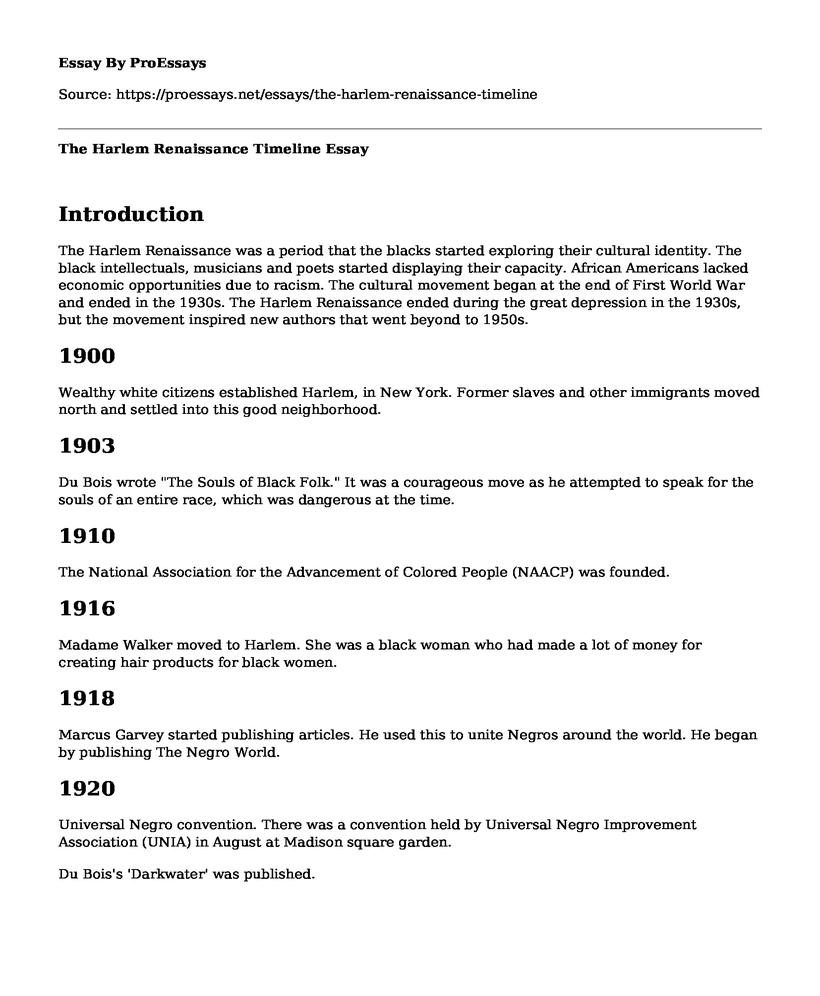Introduction
The Harlem Renaissance was a period that the blacks started exploring their cultural identity. The black intellectuals, musicians and poets started displaying their capacity. African Americans lacked economic opportunities due to racism. The cultural movement began at the end of First World War and ended in the 1930s. The Harlem Renaissance ended during the great depression in the 1930s, but the movement inspired new authors that went beyond to 1950s.
1900
Wealthy white citizens established Harlem, in New York. Former slaves and other immigrants moved north and settled into this good neighborhood.
1903
Du Bois wrote "The Souls of Black Folk." It was a courageous move as he attempted to speak for the souls of an entire race, which was dangerous at the time.
1910
The National Association for the Advancement of Colored People (NAACP) was founded.
1916
Madame Walker moved to Harlem. She was a black woman who had made a lot of money for creating hair products for black women.
1918
Marcus Garvey started publishing articles. He used this to unite Negros around the world. He began by publishing The Negro World.
1920
Universal Negro convention. There was a convention held by Universal Negro Improvement Association (UNIA) in August at Madison square garden.
Du Bois's 'Darkwater' was published.
1923
Finding out who is the Negro's greatest enemy.
Marcus Garvey, "The Negro's Greatest Enemy." Marcus was explaining how the white was being the enemy of the African Americans progress.
Jean Toomer wrote the 'Cane,' an epic poem that broke the experimental ground in the world American literature.
Claude McKay published an essay "Soviet Russia and the Negro" to give a call to Harlem Renaissance to embrace communism.
1925
Alain Locke's The New Negro: An Interpretation. The book defined the Harlem Renaissance and gave the blacks evolving identity.
Countee Cullen 'Color' was published. Cullen won the award at the Crisis award ceremony held at renaissance casino.
1926
Countee Cullen became assistant Editor of Opportunity. He started writing "The Dark Tower."
Langston Hughes wrote, "The Weary Blues" which became the first collection of poetry of Harlem Renaissance.
1927
In Abraham's bosom won the Pulitzer award. Paul Green wrote it.
Harlem Globetrotters was established
1928
"Social event the decade." Cullen Green married Nina Yolande, the daughter of Du Bois.
Harlem: A Forum of Negro's life was published. Wallace Thurman was the author.
1929
Despite the Great Depression, Harlem, written by Wallace Thurman, opened on Broadway. It became the most successful play by a black author of its time in that year.
"The black Christ and other poems" written by Cullen was published.
1930
The green pastures, which was musical, was opened on Broadway.
Black Muslims in Detroit opened an Islam temple called Universal Temple of Tranquility.
1935
Porgy and Bess was opened on Broadway. It was a musical with an all-black cast on Broadway, which was controversial at the time. It was a production of the movement "single tear."
1937
Zora Hurston, African American author, published the novel "Their Eyes Were Watching God" which was considered the last novel of the Harlem Renaissance.
1945
Langston Hughes wrote "The Big Sea." It was an autobiography of Langston during the Harlem Renaissance.
1952
Ralph Ellison wrote "The Invisible Man." It came after the Harlem Renaissance was over. The book defines the new black and the masculine identity in the free New York City. It became a major American novel of the 20th century.
Cite this page
The Harlem Renaissance Timeline. (2022, Mar 27). Retrieved from https://proessays.net/essays/the-harlem-renaissance-timeline
If you are the original author of this essay and no longer wish to have it published on the ProEssays website, please click below to request its removal:
- Essay Sample on Ethical Issues in Multicultural Counseling
- and Effects of Popular Culture against Historical Accuracy
- Homogeneity of the Middle East Essay Example
- Personal Crisis Inventory and American Strength Inventory Essay
- Essay Example on Foster Care Diversity: Examining the Unique Experiences of Foster Children
- Essay on Autoethnography: Exploring Personal Experiences & Cultural Perspectives
- Native Americans' Economic Growth and Prosperity During 1865-1898: A Brief History - Essay Sample







